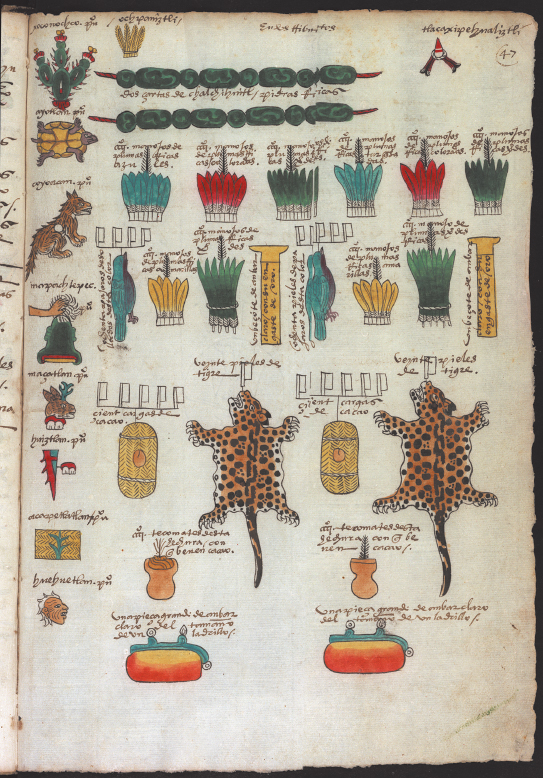Why was tribute important in the Mexican empire?
Printed Page 23

THE VAST MAJORITY of the 80 million people who lived in the Western Hemisphere in the 1490s inhabited Mesoamerica and South America, where the population approximately equaled that of Europe. Like their much less numerous counterparts north of the Rio Grande, these people lived in a natural environment of tremendous diversity. Among all these cultures, the Mexica stood out. Their empire stretched from coast to coast across central Mexico, encompassing between 8 million and 25 million people (experts disagree about the total population). Their significance in the history of the New World after 1492 dictates a brief survey of their culture and society.
CHRONOLOGY
c. AD 1325
- – Small bands of Mexica settle on a marshy island in Lake Texcoco.
c. 1490
- – Mexican empire stretches from coast to coast in central Mexico and encompasses between 8 and 25 million people.
AD 1492
- – Christopher Columbus arrives in New World, beginning European colonization.
 A people whose empire stretched from coast to coast across central Mexico and who numbered as many as 25 million. The Mexican culture was characterized by steep hierarchy and devotion to the war god Huitzilopochtli.
A people whose empire stretched from coast to coast across central Mexico and who numbered as many as 25 million. The Mexican culture was characterized by steep hierarchy and devotion to the war god Huitzilopochtli.
The Mexica began their rise to prominence about 1325, when small bands settled on a marshy island in Lake Texcoco, the site of the future city of Tenochtitlán, the capital of the Mexican empire. Resourceful, courageous, and cold-blooded warriors, the Mexica were often hired out as mercenaries for richer, more settled tribes.
The empire exemplified the central values of Mexican society and contributed far more to Mexican society than victims for sacrifice. At the most basic level, the empire functioned as a military and political system that collected tribute from subject peoples. The Mexica forced conquered tribes to pay tribute in goods, not money. Tribute redistributed to the Mexica as much as one-third of the goods produced by conquered tribes. It included everything from candidates for human sacrifice to textiles and basic food products as well as exotic luxury items such as gold, turquoise, and rare bird feathers.
 The goods the Mexica collected from conquered peoples, from basic food products to candidates for human sacrifice. Tribute engendered resentment among the Mexica’s subjects, creating a vulnerability the Spanish would later exploit.
The goods the Mexica collected from conquered peoples, from basic food products to candidates for human sacrifice. Tribute engendered resentment among the Mexica’s subjects, creating a vulnerability the Spanish would later exploit.
Tribute reflected the fundamental relations of power and wealth that pervaded the Mexican empire. The relatively small nobility of Mexican warriors, supported by a still smaller priesthood, possessed the military and religious power to command the obedience of thousands of non-noble Mexicans and of millions of non-Mexicans in subjugated colonies. The Mexican elite exercised their power to obtain tribute and thereby to redistribute wealth from the conquered to the conquerors, from the commoners to the nobility, from the poor to the rich.
The Mexica, at a Glance
On the whole, the Mexica did not interfere much with the internal government of conquered regions. Instead, they usually permitted the traditional ruling elite to stay in power — so long as they paid tribute. Subjugated communities felt exploited by the constant payment of tribute to the Mexica. The high level of discontent among subject peoples constituted the soft, vulnerable underbelly of the Mexican empire, a fact that Spanish intruders exploited after 1492 to conquer the Mexica.
CHAPTER LOCATOR
When and why do historians rely on the work of archaeologists?
How and why did humans migrate into North America?
Why did Archaic Native Americans shift to foraging and hunting smaller animals?
How did agriculture influence Native American cultures?
What cultural similarities did native peoples of the Western Hemisphere share in the 1490s?
Why was tribute important in the Mexican empire?
Conclusion: How do we understand the worlds of ancient Americans?
 LearningCurve
LearningCurve
Check what you know.
The Mexica, at a Glance
> The Mexica, at a Glance
- By the 1490s, the Mexica ruled an empire that covered more land than Spain and Portugal combined and contained almost three times as many people.
- Warriors were the most important members of society. The Mexica worshipped the war god Huitzilopochtli.
- Capturing prisoners in battle was considered the highest act of bravery; prisoners were sacrificed to Huitzilopochtli.
- The Mexica believed that human sacrifice fed the sun’s craving for blood, which kept the sun aflame and prevented the fatal descent of everlasting darkness and chaos.
- Wealth collected from conquered peoples gave Mexicans the means with which to build the cities, temples, markets, and luxuriant gardens that so impressed the Spaniards upon their arrival in the New World.
QUICK REVIEW
Question 1.11
How did the conquest and creation of an empire exemplify the central values of Mexican society?